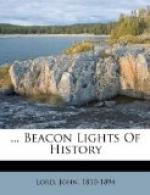This treatise would seem to be a thesaurus of both Patristic and Mediaeval learning; not a dictionary of knowledge, but a system of truth severely elaborated in every part,—a work to be studied by the Mediaeval students as Calvin’s “Institutes” were by the scholars of the Reformation, and not far different in its scope and end; for the Patristic, the Mediaeval, and the Protestant divines did not materially differ in reference to the fundamental truths pertaining to God, the Incarnation, and Redemption. The Catholic and Protestant divines differ chiefly on the ideas pertaining to government and ecclesiastical institutions, and the various inventions of the Middle Ages to uphold the authority of the Church, not on dogmas strictly theological. A student in theology could even in our times sit at the feet of Thomas Aquinas, as he could at the feet of Augustine or Calvin; except that in the theology which Thomas Aquinas commented upon there is a cumbrous method, borrowed from Aristotle, which introduced infinite distinctions and questions and definitions and deductions and ramifications which have no charm to men who have other things to occupy their minds than Scholastic subtilties, acute and logical as they may be. Thomas Aquinas was raised to combat, with the weapons most esteemed in his day, the various forms of Rationalism, Pantheism, and Mysticism which then existed, and were included in the Nominalism of his antagonists. And as long as universities are centres of inquiry the same errors, under other names, will have to be combated, but probably not with the same methods which marked the teachings of the “angelical doctor.” In demolishing errors and systematizing truth he was the greatest benefactor to the cause of “orthodoxy” that appeared in Europe for several centuries, admired for his genius as much as Spencer and other great lights of science are in our day, but standing preeminent and lofty over all, like a beacon light to give both guidance and warning to inquiring minds in every part of Christendom. Nor could popes and sovereigns render too great honor to such a prodigy of genius. They offered him the abbacy of Monte Cassino and the archbishopric of Naples, but he preferred the life of a quiet student, finding in knowledge and study, for their own sake, the highest reward, and pursuing his labors without the impedimenta of those high positions which involve ceremonies and cares and pomps, yet which most ambitious men love better than freedom, placidity, and intellectual repose. He lived not in a palace, as he might have lived, surrounded with flatterers, luxuries, and dignities, but in a cell, wearing his simple black gown, and walking barefooted wherever he went, begging his daily bread according to the rules of his Order. His black gown was not an academic badge, but the Dominican dress. His only badge of distinction was the doctors’ cap.




